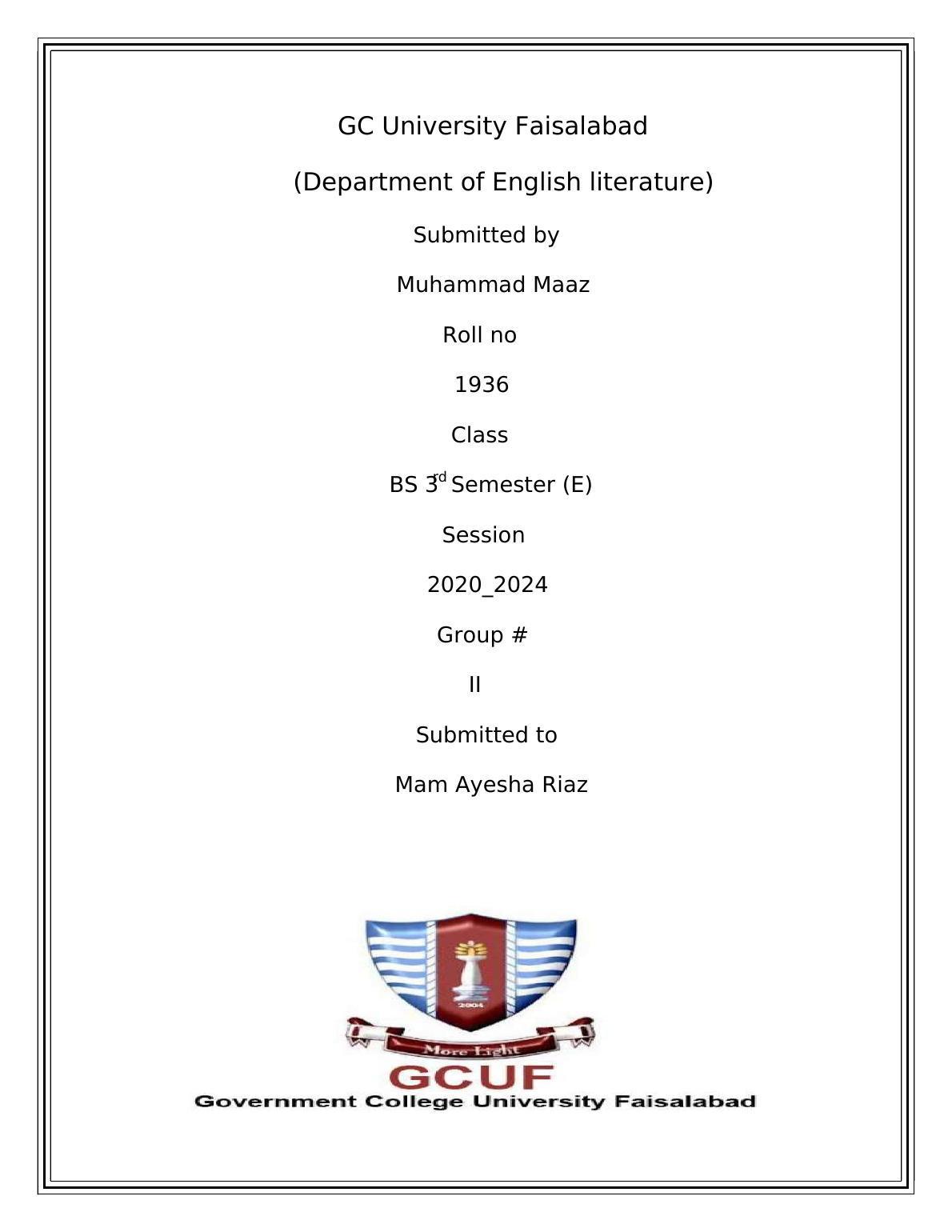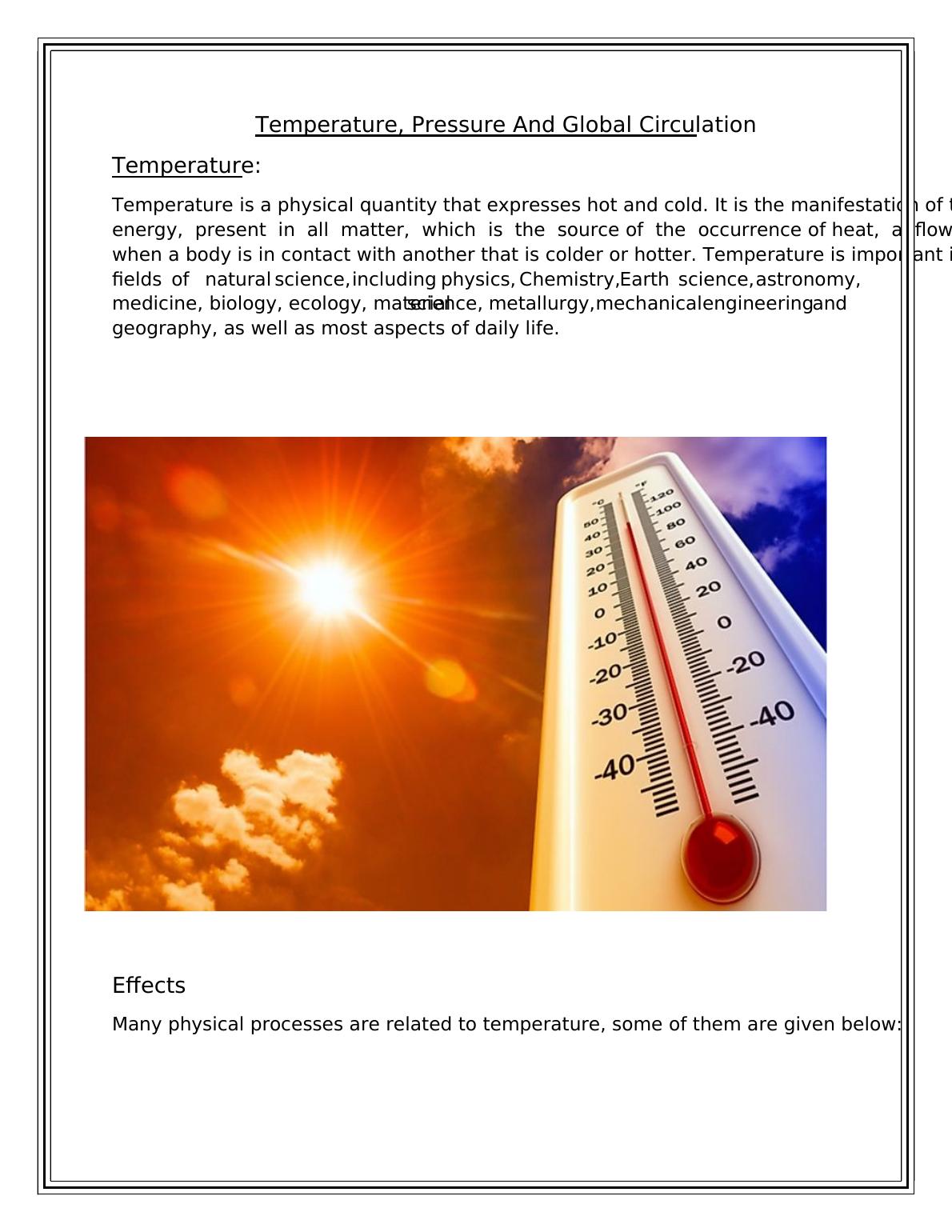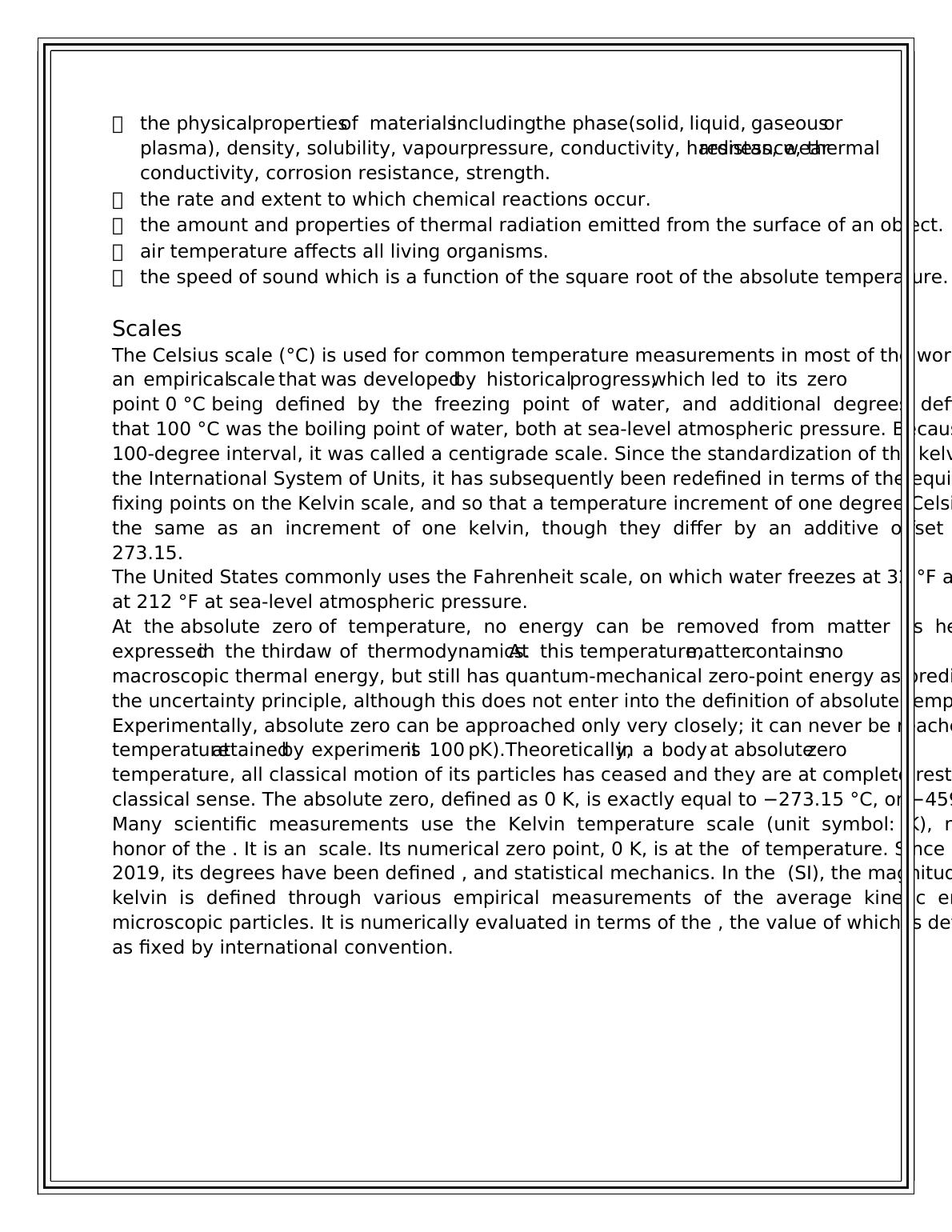What is global atmospheric circulation?
Added on 2022-03-04
9 Pages2073 Words31 Views
GC University Faisalabad
(Department of English literature)
Submitted by
Muhammad Maaz
Roll no
1936
Class
BS 3rd Semester (E)
Session
2020_2024
Group #
II
Submitted to
Mam Ayesha Riaz
(Department of English literature)
Submitted by
Muhammad Maaz
Roll no
1936
Class
BS 3rd Semester (E)
Session
2020_2024
Group #
II
Submitted to
Mam Ayesha Riaz

Temperature, Pressure And Global Circulation
Temperature:
Temperature is a physical quantity that expresses hot and cold. It is the manifestation of thermal
energy, present in all matter, which is the source of the occurrence of heat, a flow of energy,
when a body is in contact with another that is colder or hotter. Temperature is important in all
fields of natural science, including physics, Chemistry, Earth science, astronomy,
medicine, biology, ecology, material science, metallurgy, mechanical engineering and
geography, as well as most aspects of daily life.
Effects
Many physical processes are related to temperature, some of them are given below:
Temperature:
Temperature is a physical quantity that expresses hot and cold. It is the manifestation of thermal
energy, present in all matter, which is the source of the occurrence of heat, a flow of energy,
when a body is in contact with another that is colder or hotter. Temperature is important in all
fields of natural science, including physics, Chemistry, Earth science, astronomy,
medicine, biology, ecology, material science, metallurgy, mechanical engineering and
geography, as well as most aspects of daily life.
Effects
Many physical processes are related to temperature, some of them are given below:

the physical properties of materials including the phase (solid, liquid, gaseous or
plasma), density, solubility, vapourpressure, conductivity, hardness, wear resistance, thermal
conductivity, corrosion resistance, strength.
the rate and extent to which chemical reactions occur.
the amount and properties of thermal radiation emitted from the surface of an object.
air temperature affects all living organisms.
the speed of sound which is a function of the square root of the absolute temperature.
Scales
The Celsius scale (°C) is used for common temperature measurements in most of the world. It is
an empirical scale that was developed by historical progress, which led to its zero
point 0 °C being defined by the freezing point of water, and additional degrees defined so
that 100 °C was the boiling point of water, both at sea-level atmospheric pressure. Because of the
100-degree interval, it was called a centigrade scale. Since the standardization of the kelvin in
the International System of Units, it has subsequently been redefined in terms of the equivalent
fixing points on the Kelvin scale, and so that a temperature increment of one degree Celsius is
the same as an increment of one kelvin, though they differ by an additive offset of exactly
273.15.
The United States commonly uses the Fahrenheit scale, on which water freezes at 32 °F and boils
at 212 °F at sea-level atmospheric pressure.
At the absolute zero of temperature, no energy can be removed from matter as heat, a fact
expressed in the third law of thermodynamics. At this temperature, matter contains no
macroscopic thermal energy, but still has quantum-mechanical zero-point energy as predicted by
the uncertainty principle, although this does not enter into the definition of absolute temperature.
Experimentally, absolute zero can be approached only very closely; it can never be reached (least
temperature attained by experiment is 100 pK).Theoretically, in a body at absolute zero
temperature, all classical motion of its particles has ceased and they are at complete rest in this
classical sense. The absolute zero, defined as 0 K, is exactly equal to −273.15 °C, or −459.67 °F.
Many scientific measurements use the Kelvin temperature scale (unit symbol: K), named in
honor of the . It is an scale. Its numerical zero point, 0 K, is at the of temperature. Since May,
2019, its degrees have been defined , and statistical mechanics. In the (SI), the magnitude of the
kelvin is defined through various empirical measurements of the average kinetic energies of
microscopic particles. It is numerically evaluated in terms of the , the value of which is defined
as fixed by international convention.
plasma), density, solubility, vapourpressure, conductivity, hardness, wear resistance, thermal
conductivity, corrosion resistance, strength.
the rate and extent to which chemical reactions occur.
the amount and properties of thermal radiation emitted from the surface of an object.
air temperature affects all living organisms.
the speed of sound which is a function of the square root of the absolute temperature.
Scales
The Celsius scale (°C) is used for common temperature measurements in most of the world. It is
an empirical scale that was developed by historical progress, which led to its zero
point 0 °C being defined by the freezing point of water, and additional degrees defined so
that 100 °C was the boiling point of water, both at sea-level atmospheric pressure. Because of the
100-degree interval, it was called a centigrade scale. Since the standardization of the kelvin in
the International System of Units, it has subsequently been redefined in terms of the equivalent
fixing points on the Kelvin scale, and so that a temperature increment of one degree Celsius is
the same as an increment of one kelvin, though they differ by an additive offset of exactly
273.15.
The United States commonly uses the Fahrenheit scale, on which water freezes at 32 °F and boils
at 212 °F at sea-level atmospheric pressure.
At the absolute zero of temperature, no energy can be removed from matter as heat, a fact
expressed in the third law of thermodynamics. At this temperature, matter contains no
macroscopic thermal energy, but still has quantum-mechanical zero-point energy as predicted by
the uncertainty principle, although this does not enter into the definition of absolute temperature.
Experimentally, absolute zero can be approached only very closely; it can never be reached (least
temperature attained by experiment is 100 pK).Theoretically, in a body at absolute zero
temperature, all classical motion of its particles has ceased and they are at complete rest in this
classical sense. The absolute zero, defined as 0 K, is exactly equal to −273.15 °C, or −459.67 °F.
Many scientific measurements use the Kelvin temperature scale (unit symbol: K), named in
honor of the . It is an scale. Its numerical zero point, 0 K, is at the of temperature. Since May,
2019, its degrees have been defined , and statistical mechanics. In the (SI), the magnitude of the
kelvin is defined through various empirical measurements of the average kinetic energies of
microscopic particles. It is numerically evaluated in terms of the , the value of which is defined
as fixed by international convention.

End of preview
Want to access all the pages? Upload your documents or become a member.
Related Documents
Report on Physics Practicallg...
|21
|3167
|52
Temperature and Heat Question Answer 2022lg...
|8
|1324
|14
(PDF) Thermofluids Laboratory: Heat Transfer Experimentlg...
|15
|1629
|305
PPSC Chemistry Question 2022lg...
|31
|820
|23
CH321 Thermodynamics Theory Assignmentlg...
|8
|586
|16
